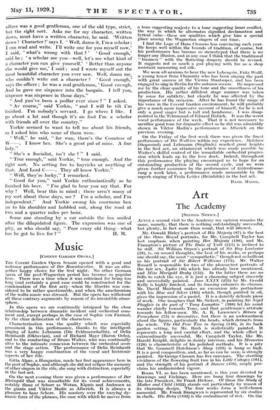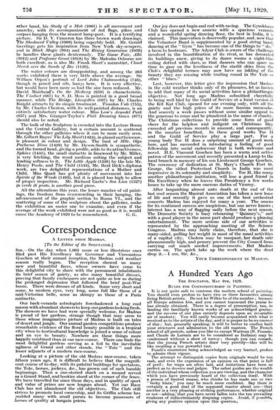Art
The Academy
[SECOND NOTICE.]
ArrEit a second visit to the Academy my opinion remains the same, namely, that there is nothing outstandingly successful, but plenty, in fact more than usual, that will interest.
Mr. Oswald Birley's portrait of His Majesty (87) is the best of the three Royal portraits, for Mr. Campbell Taylor has lost emphasis when painting Her Majesty {198), and Mr. Frampton's picture of The Duke of York (211) is inclined to be stiff. Sir William Orpen's portrait of Sir Ray Lankester (18), is, on second thoughts, the best of his works, or perhaps one should say, the most " sympathetic," though not so brilliant as his portrait of Sir Robert Williams (173). Mr. Walter Russell is responsible for two of the pleasantest portraits of the fair sex, Lydia (40) which has already been mentioned, and Miss Marigold Braby (152). In the latter there are no frills to catch the eye, it is just a charming subject sincerely and successfully painted. Jane XXIX (258) by Mr. Gerald Kelly is highly finished, and its framing enhances its charms. Mr. David Muirhead makes an excursion into portraiture with his Blue and Silver (168) which, though painted in oil, gives the impression of a pastel. It is a daintily delicate piece of work. One imagines that Mr. Sickert, in painting Sir Nigel Playfair in the part of " Tony Lumpkin" (888) let his mind wander chiefly towards Tony, and that gentleman's attitude towards his fellow-men. Mr. A. K. Lawrence's Return of Persephone (75) is decorative, but there is an awkwardness about the figures, particularly the heads, which detracts from the whole. The Old Pear Tree in Spring (146), in its back garden setting, by Mr. Bush is realistically painted. It represents a long and careful effort, and the whole effect is extraordinarily successful. Mr. Campbell Taylor, like Mr. Harold Knight, delights in dainty interiors, and his Memories (128) is characteristic of his polished methods. It is a pity that Mr. Gemmell Hutchison's Sleep (259) is hung so high. It is a good composition, and, as far as can be seen, is strongly painted. Sir George Clausen has five canvases. The startling vividness of the flowering fruit tree in his Little Cottages (161), and the strength of his portrait A Dancer (456), amply pro- claim his undiminished vigour.
Room VI, as has been mentioned, is this year devoted to Drawings and Etchings. Here are hung four drawings by the late President, Sir Frank Dicksee. Of these the Study of Mother and Child (1022) stands out particularly by reason of its charming design. The four works form a well-chosen memorial. Mr. Frank Brangwyn is represented by six studies in chalk. His Baby (1102) is the embodiment of rest. On the other hand, his Study of a Mob (1061) is all movement and - anarchy, with its accompaniment of red flags, pikes and corpses hanging from the nearest lamp-post. It is a terrifying picture. Sir D. Y. Cameron has three brown wash drawings, the Shadowed Valley (1009) being superbly bold. Mr. Gerald Geerlings gets his inspiration from New York sky-scrapers, and in Black Magic (994) and The Rising Generation (1036) he handles these giants dexterously. The Goose. Pair, Albi (1012) and Professor Grant (1018) by Mr. Malcolm Osborne are both excellent, as is also Mr. Frank Short's mezzotint, Cloud March over the Sands of Dec (1120).
The water colours are disappointing, and among the 263 works exhibited there is very little above the average. Sir William Orpen's portrait of Lord John Cholmondeley (746), though in pencil and oils, hangs here. It is very effective, but would have been more so had the size been reduced. Mr. David Muirhead's On the Medway (659) is characteristic. The Viaduct (687) by S. D. Moss is painted in a good broad manner, while The Bridge, Llangollen (697) by Mr. Charles Knight attracts by its simple treatment. Taunton Vale (755), by Mr. Charles Cheston, with its well-painted distances, is an entirely satisfactory water colour. Miss Low's Arundel Park (857) and Mrs. Granger-Taylor's Pink Dressing Gown (877) should also be noted.
The bulk of the Sculpture is crowded into the Lecture Room and the Central Gallery, but a certain amount is scattered through the other galleries where it can be more easily seen. Mr. Gilbert Bayes' The Lily Maid (1424), in glazed earthenware, is pleasant in colour and design. The bust of Mlle. Olga Pavlovna Dena (1429) by Mr. Dyson-Smith is sympathetic, and the turned head, giving a profile, adds to its attractiveness. Sphinx (1441), the small statuette in limewood by Mr. Miller, is very fetching, the wood medium suiting the subject and lending softness to it. The Little Apple (1538) by the late Mr. Henry Poole, and The Child (1543), Mr. Reid Dick's diploma work, are two delightful representations of a Mother and Child. Miss Quoit has got plenty of movement into her Spirits of the Winds (1498), but it is placed too high to allow of proper inspection, Mr. Richard Garbe's Sea Lion (1527) in verde di prato, is another good piece.
All the alterations this year, the lesser number of oil paint- ings, the freedom from overcrowding in their hanging, the advancement of the graphic section to Room VI., and the scattering of some of the sculpture about the galleries, make the exhibition an easier one to examine, and even if the average of the work exhibited were not as good as it is, would cause the Academy of 1929 to be remembered. G. G.











































 Previous page
Previous page